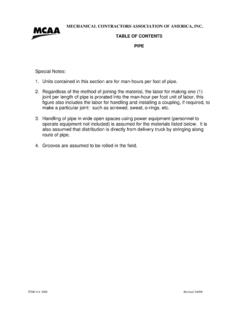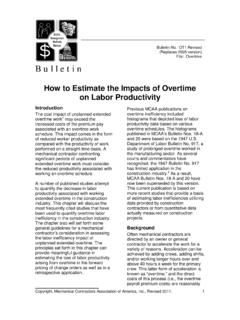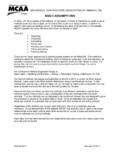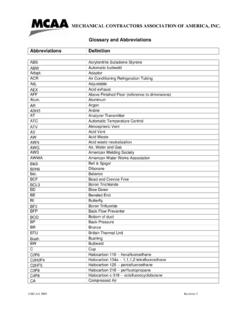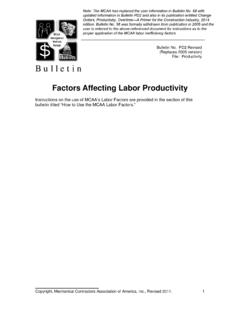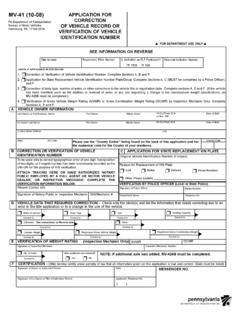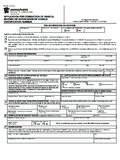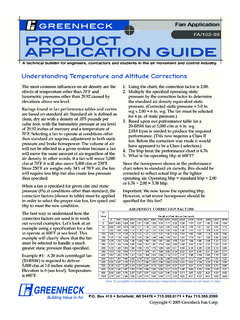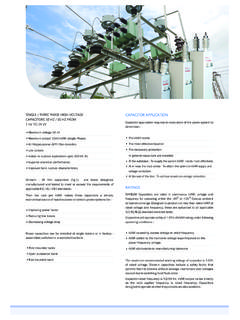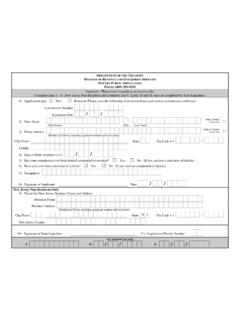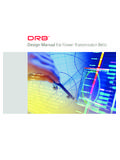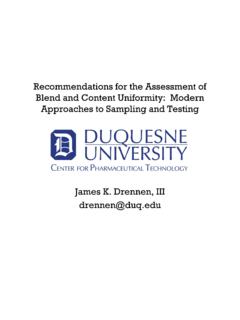Transcription of MECHANICAL CONTRACTORS ASSOCIATION OF …
1 MECHANICAL CONTRACTORS ASSOCIATION OF america , INC. LABOR correction FACTORS MCAA 2006 Revised 03/11/2013 The Labor units contained in this manual are for average working conditions as defined in Basic Assumptions . To adjust for job conditions, other than average, the following factors should be applied, as they exist. It is probable that more than one of these conditions exist, that being the case, the factors would be additive. For additional considerations, see MCAA Management Methods Bulletin No. CO1 located in Appendix. All correction factors should be applied to entire system labor and not just a specific activity or component, whether using the Component Method or the Work Activity Method. For example, for x-ray quality welds you should take the entire labor related to the installation of the piping system and apply the correction factor.
2 Another example would be for exterior work where cold weather may affect productivity. In this case you would apply the correction factor for cold weather to all the labor associated with work outside only. CONDITIONS FACTORS I. BELOW GRADE: A. Ditch-Four (4) feet and below 2% to 4% per ft. of depth below 4 ft B. Other conditions to be considered but no factors suggested 1. Multiple levels below grade 2. Basement greater than ten (10) Feet below grade 3. Mud 4. Working on or in rubble fill 5. Working on or in compacted or non-compacted fill 6. Grade contour 7. Dewatering 8. Standing water 9. Soil composition (rock, quicksand, etc.) II REDUCED HEIGHT WORKING AREA A. Crawl spaces & tunnels-Four (4) feet & less 30% to 40% B. Other conditions to be considered but no factors suggested. 1. Walking tunnels 2. Crawl spaces on grade III GRADE LEVEL AND ABOVE: A. Piping installed between ten (10) feet and twenty (20) feet 1% to 2% per additional.
3 Feet of height above 10 ft. B. Working off dirt floor (such as ladder work) 30% to 40% C. Multi-story building above 3rd floor 1% to 2% per floor Multi-story building above 20th floor 2% to 4% per floor D. Other conditions to be considered but no factors suggested. 1. Piping above furred ceilings 2. Piping in furred vertical spaces 3. Piping in furred horizontal beams 4. Reducing height of scaffold for moving due to overload interference 5. Personnel hoist, random roving 6. Personnel hoist, call system 7. Material Hoist 8. Crane facilities 9. Toilet facility location 10. Ladders between floors 11. Stairs between floors MECHANICAL CONTRACTORS ASSOCIATION OF america , INC. LABOR correction FACTORS MCAA 2006 Revised 03/11/2013 CONDITIONS FACTORS IV ENVIRONMENTAL A.
4 Excessive hot or cold area, indoor or outdoor 10% to 30% 1. Items to be considered a) Effective skin temperature (chill factor) see Wind/Temp chart included in this section. b) Tunnels and operating equipment rooms c) Pumping ditches due to rain or snow B. Other conditions to be considered but no factors suggested. 1. Inadequate ventilation 2. Hazardous working conditions 3. Cleaning conditions required because of sand and dust. 4. Inadequate lighting 5. Unhealthy working conditions such as, welding of galvanized materials, spraying of fireproof materials and chemical cleaning. V JOB CONDITIONS A. Excessive job accelerations, caused by the following: See MCAA Management Methods Bulletin CO1 located in Appendix. 1. Stacking of trades or concurrent operations 2. Crew size inefficiency 3. Dilution of supervision 4. Ripple effect-excessive revisions B. Existing Building-owner occupied C.
5 Shift work 1. Swing shift-increase labor by 20% 2. Graveyard, increase labor by 30% D. Fatigue and/or premium time (overtime) See MCAA Management Methods Bulletin CO1 located in Appendix. E. Other conditions to be considered: Some factors included in MCAA 1. Working in finished area Management Methods Bulletin CO1 2. Working in small rooms or cubicles located in Appendix. 3. Morale and attitude 4. Temporary operations of systems 5. Portal to portal (Work area fenced) 6. Closeness of stockpile (excessive materials handling) 7. Security check (craft person entering and leaving site) 8. Craft person experience (this could be negative multiplier such as repetitive work) 9. Working in occupied or hazardous areas 10. Manpower availability 11. Closeness to job office 12. Work above owners equipment 13. Working in and around areas where owner has beneficial occupancy 14.
6 Area practices (such as coffee breaks) 15. Floor areas above 15000 sq. feet (100 x 150) 16. Surgical or clean room conditions 17. Unusual productivity by local work forces 18. Unusual or unreasonable requirements by owner or engineer MECHANICAL CONTRACTORS ASSOCIATION OF america , INC. LABOR correction FACTORS MCAA 2006 Revised 03/11/2013 VI. OTHER CONDITIONS A. Security requirements (site access, badges, search) B. Affixing to or drilling through excessively hard concrete (flint, aggregate, etc.) C. Access into building and to equipment D. Shutdown and tie-ins (example, overtime, system in operation) E. Protection of owner s merchandise (equipment, furniture, fixtures, etc.) F. Erection of temporary partitions G. Erection of dust closures H. Daily dismantling and erection of scaffolds I. Occupants of existing area such as, patients mentally retarded children, etc.
7 J. Special cleanup requirements K. When fittings are joined to fittings, proper adjustment should be made to labor units to correct for duplicated labor VII. COMPLIANCE WITH ALL FEDERAL, STATE AND LOCAL SAFETY REQUIREMENTS. ESTIMATED COSTS FOR ON-SITE SAFETY PRACTICES SAFETY CONSIDERATION WORK FUNCTION FACTORS Confined Space Monitoring environment and work area Full time attendant 1 Man-hour per Crew-hour Fall Protection Mid to high fall protection Aerial Lift Platforms Working tied-off in full body harness Ladder Safety Properly tied-off ladder utilizing a full body harness Hazardous Materials Working in tyvek suit with respirator Lockout-Tagout Per piece of equipment Excavation Working in shored or protective enclosure could be defined as confined space Scaffolding Safe working practices for erection and dismantling Heavy Equipment Proper rigging and general safety requirements Notes: 1. Argon purge may be considered confined space therefore ventilation and monitoring may be required (Cost/man-hours/space requirements) 2.
8 The cost of these on-site safety requirements could be translated into a percent (%) cost of labor. VIII. correction FOR X-RAY QUALITY WELDING: Of 21 MCAA CONTRACTORS surveyed, it was determined that the average additional time for x-ray quality welds in shop environments is 27 percent and for field environment is 47 percent. IX. INSTUMENTATION AND CLEAN ROOM Refer to basic assumption for specialty application correction factors Instrumentation Clean room
